
Florence Nightingale was an English social reformer, statistician and the founder of modern nursing. Nightingale came to prominence while serving as a manager and trainer of nurses during the Crimean War, in which she organised care for wounded soldiers at Constantinople. She significantly reduced death rates by improving hygiene and living standards. Nightingale gave nursing a favourable reputation and became an icon of Victorian culture, especially in the persona of "The Lady with the Lamp" making rounds of wounded soldiers at night.

Mary Jane Seacole was a British nurse and businesswoman.
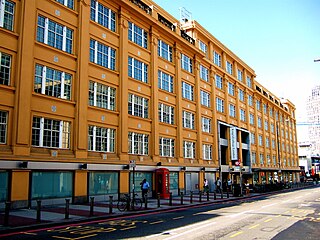
The Florence Nightingale Faculty of Nursing, Midwifery & Palliative Care is an academic faculty within King's College London. The faculty is the world's first nursing school to be continuously connected to a fully serving hospital and medical school. Established on 9 July 1860 by Florence Nightingale, the founder of modern nursing, it was a model for many similar training schools through the UK, Commonwealth and other countries for the latter half of the 19th century. It is primarily concerned with the education of people to become nurses and midwives. It also carries out nursing research, continuing professional development and postgraduate programmes. The Faculty forms part of the Waterloo campus on the South Bank of the River Thames and is now one of the largest faculties in the university.

A pinning ceremony is a symbolic welcoming of newly graduated or soon-to-be graduated nurses into the nursing profession.
Lucy Osburn was an English nurse trained at the School of Nursing founded by Florence Nightingale. She is regarded as the founder of modern nursing in Australia.

Dame Alicia Frances Jane Lloyd Still, DBE, RRC, SRN (1869–1944) was a British nurse, teacher, hospital matron and leader of her profession. She was one of the leaders in the campaign for state registration of nurses. Following the Nurses Registration Act 1919, she was a member of the General Nursing Council (1920-1937). As chairwoman of the General Nursing Council's first Education and Examinations Committee she helped establish the first national examination standards for the registration of nurses.
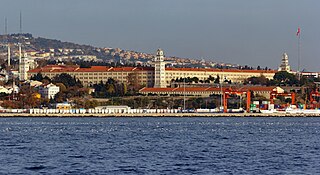
Selimiye Barracks, also known as Scutari Barracks, is a Turkish Army barracks located in the Üsküdar district on the Asian side of Istanbul, Turkey. It was originally built in 1800 by Sultan Selim III for the soldiers of the newly established Nizam-ı Cedid within the framework of the Ottoman military reform efforts. Today, it serves as the headquarters of the First Army of Turkish Land Forces.

Agnes Elizabeth Jones of Fahan, County Donegal, Ireland became the first trained Nursing Superintendent of Liverpool Workhouse Infirmary. She gave all her time and energy to her patients and died at the age of 35 from typhus fever. Florence Nightingale said of Agnes Elizabeth Jones, ‘She overworked as others underwork. I looked upon hers as one of the most valuable lives in England.’
Florence Nightingale (1820–1910), considered the founder of educated and scientific nursing and widely known as "The Lady with the Lamp", wrote the first nursing notes that became the basis of nursing practice and research. The notes, entitled Notes on Nursing: What it is, and What it is Not (1860), listed some of her theories that have served as foundations of nursing practice in various settings, including the succeeding conceptual frameworks and theories in the field of nursing. Nightingale is considered the first nursing theorist. One of her theories was the Environmental Theory, which incorporated the restoration of the usual health status of the nurse's clients into the delivery of health care—it is still practiced today.
The word "nurse" originally came from the Latin word "nutrire", meaning to suckle, referring to a wet-nurse; only in the late 16th century did it attain its modern meaning of a person who cares for the infirm.

Eva Charlotte Ellis Luckes was Matron of The London Hospital from 1880 to 1919.
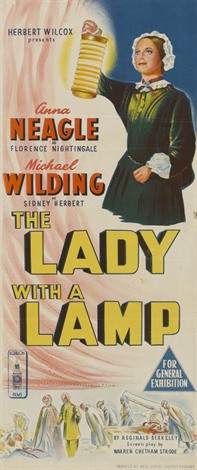
The Lady with a Lamp is a 1951 British historical drama film directed by Herbert Wilcox and starring Anna Neagle, Michael Wilding and Felix Aylmer. The film depicts the life of Florence Nightingale and her work with wounded British soldiers during the Crimean War. It was shot at Shepperton Studios outside London. Location shooting took place at Cole Green railway station in Hertfordshire and at Lea Hurst, the Nightingale family home, near Matlock in Derbyshire. The film's sets were designed by the art director William C. Andrews. It is based on the 1929 play The Lady with a Lamp by Reginald Berkeley.
The history of nursing in the United Kingdom relates to the development of the profession since the 1850s. The history of nursing itself dates back to ancient history, when the sick were cared for in temples and places of worship. In the early Christian era, nursing in the United Kingdom was undertaken by certain women in the Christian Church, their services being extended to patients in their homes. These women had no real training by today's standards, but experience taught them valuable skills, especially in the use of herbs and folk drugs, and some gained fame as the physicians of their era. Remnants of the religious nature of nurses remains in Britain today, especially with the retention of the job title "Sister" for a senior female nurse.
The Florence Nightingale Foundation (FNF) is a charity organization in the United Kingdom that provides scholarships to nurses, midwives, and other health professionals while serving as a living memorial to the work of Florence Nightingale.
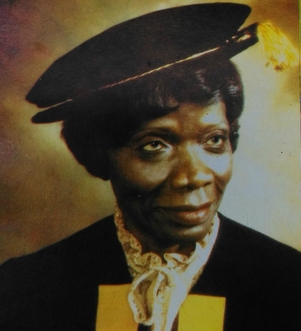
Chief Kofoworola Abeni Pratt Hon. FRCN was a Nigerian nurse who was one of the first notable black nurses to work in Britain's National Health Service. She subsequently became vice-president of the International Council of Nurses and the first black Chief Nursing Officer of Nigeria, working in the Federal Ministry of Health.

The Nightingale Hospital is a private mental health facility in Lisson Grove, Marylebone, London. It is owned by Groupe Sinoue-Sarl, which is based in Garches.
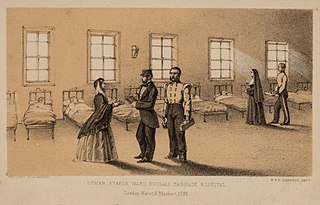
Mother Mary Francis Bridgeman R.S.M. was a nun with the Sisters of Mercy, a Roman Catholic religious congregation of women, founded in Ireland by Catherine McAuley and a pioneer nurse during the Crimean War of 1854-1856.

The statue of Mary Seacole stands in the grounds of St Thomas' Hospital, Lambeth, London. Sculpted by Martin Jennings, the statue was executed in 2016. It honours Mary Seacole, a British-Jamaican who established a "British Hotel" during the Crimean War and who was posthumously voted first in a poll of "100 Great Black Britons".

Eliza Roberts (1802–1878) was an English nurse who was among the first group of nurses to accompany Florence Nightingale to Scutari Hospital during the Crimean War. Nightingale regarded her as the best of her nurses and appointed her Head Nurse.
















